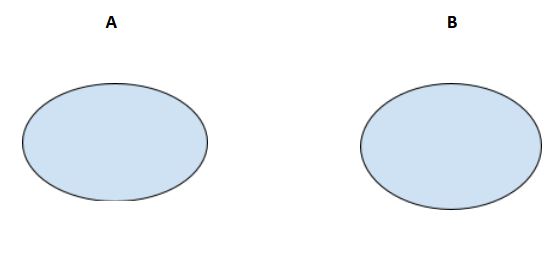
Rachit Kumar SaxenaManager-Editorial
What are Disjoint Sets?
In ‘Set Theory,’ two sets are disjoint if their intersection results in a null or empty set. There are no common elements in these sets. There is only one condition for a set to be disjoint. And that is, the intersection of the two sets should be an empty set.
For example, if you have two sets, A = {1,2, 3}, and B = {5, 6, 8}, such sets are disjoint since they have no common elements and their intersection becomes a null set.
Representing Disjoint Sets Using Venn Diagrams
To represent disjoint sets using Venn Diagrams, you must draw two separate diagrams for each set.
In the above Venn Diagrams, Set A and B are two distinct sets that don’t have any common elements and are disjoint.
Pairs of Disjoint Sets
You can also extend a disjoint set to a group of sets. A pair-wise or mutually disjoint set is a collection of disjoint sets.
For example, if P contains two disjoint sets, A and B, then the collection of sets, ‘P,’ is a pair-wise or mutually disjoint set.
So, we have P = { {5}, {1, 2}, {3, 6, 8} }
Importance and Weightage
The concept of disjoint sets for class 11 is a part of the chapter, ‘Sets.’ Here, you will learn about disjoint sets, including what they are and how to represent them using Venn Diagrams. You will also learn about pairs of disjoint sets and how you can extend the concept of a single disjoint set to a group of sets. The chapter carries ten marks in the final examination.
Illustrative Examples on Disjoint Sets
1. Given two sets where A = {1, 2, 3, 4, 5, 6}, and B = {10, 11, 12, 13, 14, 15, 16}, find out whether they are disjoint.
Solution:
A = {1, 2, 3, 4, 5, 6} and B = {10, 11, 12, 13, 14, 15, 16}.
By observing these two sets, we can infer that there are no common elements between them. So, we conclude that they are disjoint sets.
2. Find whether the following pair of sets are disjoint.
A = {1, 2, 3, 4, 5} and B = {x: x is a natural number where 4Solution:
Given two sets A = { 1, 2, 3, 4, 5} and ‘B’ is the set of natural numbers occurring between ‘4’ and ‘6.’ So, B = {4, 5, 6}.
By observing both these sets, we find that A intersection B is {4, 5}. Hence, we can conclude that the above pair of sets are not disjoint.
3. Given two sets {a, e, I, o, u} and {c, d, e, f}, find out whether they are disjoint.
Solution:
When we carry out the intersection operation between these two sets, we get the result, {e}, which is the common element. Hence, we can conclude that the two sets are not disjoint.
FAQs on Disjoint Sets
Q: What is a Disjoint Set?
Q: What are Pairs of Disjoint Sets?
Q: How do we Represent Disjoint Sets Using Venn Diagrams?
Q: Given two Sets: A = {1, 2, 3, 4}, and B = {5, 6, 7, 8}, determine if they are disjoint.
Q: What is the Condition for Non-Disjointedness?
News & Updates
Maths Sets Exam
Student Forum
Popular Courses After 12th
Exams: BHU UET | KUK Entrance Exam | JMI Entrance Exam
Bachelor of Design in Animation (BDes)
Exams: UCEED | NIFT Entrance Exam | NID Entrance Exam
BA LLB (Bachelor of Arts + Bachelor of Laws)
Exams: CLAT | AILET | LSAT India
Bachelor of Journalism & Mass Communication (BJMC)
Exams: LUACMAT | SRMHCAT | GD Goenka Test
